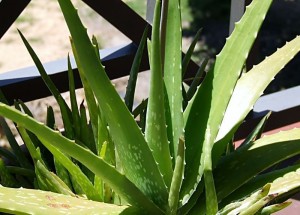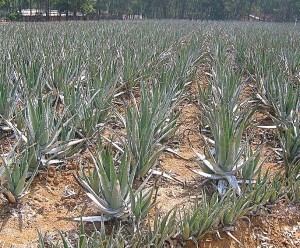 Aloe Vera (Aloe barbadensis) or medicinal aloe is a member of the Lily family, popularly known as Sabila in the Philippines. Aloe Vera is a species of succulent plant that probably originated in Northern Africa, the Canary islands and Cape Verde. The species is frequently cited as being used in herbal medicine. The transparent gel from the pulp of the meaty leaves of Aloe Vera has been used topically for thousands of years to treat wounds, skin infections, burns, and numerous other dermatologic conditions. Juice is also taken from the aloe vera leaves. The bitter juice is often prepared as a flavored drink and is used to help with digestive problems.
Aloe Vera (Aloe barbadensis) or medicinal aloe is a member of the Lily family, popularly known as Sabila in the Philippines. Aloe Vera is a species of succulent plant that probably originated in Northern Africa, the Canary islands and Cape Verde. The species is frequently cited as being used in herbal medicine. The transparent gel from the pulp of the meaty leaves of Aloe Vera has been used topically for thousands of years to treat wounds, skin infections, burns, and numerous other dermatologic conditions. Juice is also taken from the aloe vera leaves. The bitter juice is often prepared as a flavored drink and is used to help with digestive problems.
The Aloe Vera plant has long and spiked leaves. It contains numerous vitamins and minerals, enzymes, amino acids, natural sugars and agents which may be anti-inflammatory and anti-microbial. The combination and balance of the plant’s ingredients are what purportedly gives it its healing properties.
Aloe vera plants are readily available and some people keep a potted plant in the kitchen. For other uses, particularly for internal use, commercial gels and juices, which are processed under strict controls, can be found at most health food stores as well as many supermarkets.
Today Aloe Vera is used in many commercial products including cosmetics, health foods, and sun tan products.
How to grow Aloe Vera
Choosing The Location
The first step on how to grow aloe vera is to designate an area where you will grow the plant. If you are living in a mild climate, it is recommended to plant the herb in the pot and position it near the window where it can be exposed to sunlight. During the summer, you can take the pot outdoors.
If you intend to plant aloe vera outside, choose a location where the soil is well drained and has complete sunlight. In case you are growing the plant indoors, you should have available pots so you can take them out during the summer. In the cold months, you can transfer the plants inside a greenhouse.
Preparing The Garden or Site
When learning how to grow aloe vera indoors, you should grow the plant in a rich quality soil consisting of a mixture of pebbles, compost, and sand.
You need to be sure that the base of the pot is receiving good drainage. For large areas, place the plant on pots that has a minimum measurement of 18 inches. By doing this, you give the plant ample time to achieve full growth.
If you want to plant it in a greenhouse, you have to prepare a glass frame to cover it from extreme cold.
Light and Temperature
It’s best if Aloe vera plants receive indirect bright light. This basically means that you should place them near a window that receives a lot of light if they’re indoors. But be sure that the rays of the sun don’t come in direct contact with your Aloe vera plant because this could burn the plant. In other words, keep them in the shade.
When your Aloe vera plants are outdoors, be sure they’re in the shade as well. Direct sunlight will not necessarily kill them, but it will cause them to turn brown. Plus, your Aloe vera plants will dry out too quickly if they’re in direct sunlight; they may also become more susceptible to diseases as well.
Water and Soil
Use a well-drained soil to avoid standing water around the roots, which will cause rot. Water generously; wait until the soil approaches dryness before watering again.
You should water at least once a week particularly when you observe that the soil is dry. However, do not over water Aloe Vera; one or two cups of three hundred milliliters of water will be enough.
During hot seasons, the entire pot of Aloe Vera can be soaked but you have to ensure that good drainage is available so as not to rot the roots.
Fertilize
Aloe Vera needs sunlight and enough water for its own growth. Apart from that, it is advisable that you uproot all weeds to ensure that the soil retains its acidic pH. You can also add ammonium nitrate to the soil every year as a supplement. Use fertilizer sparingly and only in warm months.

Propagation
After an Aloe vera plant reaches a certain age, it will start to produce smaller plants around its base. You can then carefully pluck these baby Aloe vera plants out of the soil, and transplant them somewhere else if you like. You may want to temporarily give the baby Aloe vera plants a little more water then you normally would give a larger plant. In a few weeks, your baby Aloe vera plants should start to grow and mature.
Aloe vera plants will sometimes produce flowers if their setting is conducive enough. These flowers will produce seeds when they die off. You can then plant these seeds in the ground, and produce your own Aloe vera plants that way. Just so you know, Aloe vera plants will rarely produce flowers if they’re grown indoors.
- Cuttings root easily. Take stem cuttings, offsets or leaf cuttings in spring or summer. It is vital to let the cuttings dry for a few days before inserting in well-drained soil. Water very sparingly and do not cover with polythene or glass.
- Aloe vera will quickly start to grow small “pups” that cluster around the bottom of the plant’s base. After reaching baby finger size, the pups can be removed and started on their own, or left to increase the overall size of your plant.
Diseases
First of all, Aloe vera plants are very hardy. The only real disease that may cause your plants grief is root rot. Root rot basically happens when you water your Aloe vera plants too much. So if you simply care for them properly, then root rot will not be a problem for you.
Aloe Vera is a Good Home Remedy
The sticky interior gel of aloe vera can be used to stop the pain of burns, and it can also be applied as a skin treatment. Many over the counter acne gels and creams use aloe vera as an active ingredient. Now the subject of increased scientific study, aloe is being touted as a remedy for everything from hair loss to some types of cancer, but it does have a long, reliable history as a treatment for burns. This is a great reason to keep a couple of plants around your home.
Other beneficial uses of Aloe Vera extracts:
- The salicylates and magnesium lactate help prevent bronchitis, allergies and sinusitis.
- Mannan polysaccharides found in Aloe Vera help strengthen the immune system.
- The plant is also the source of Aloe Vera gel that can be used as a constituent in creams that moisturize the skin.
Sources: hubpages.comand Wikipedia.org; Photos: Wikipedia.org